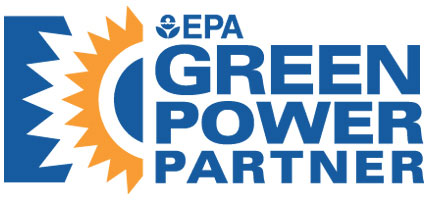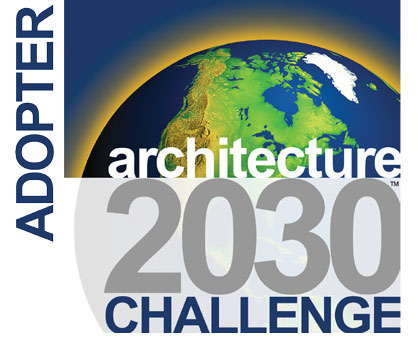LEED Features
Morrissey Engineering's Platinum LEED certification was based on several criteria that promote reduced energy consumption and environmental impact. Our building received 56 out of 69 possible credits under the LEED-NC version 2.2 rating system.
The following describes the LEED certification criteria and the features we implemented in the 4940 building that met these eco-friendly goals.
View the 4940 Building's LEED project profile here.
SUSTAINABLE SITES
Choosing a building's site and managing that site during construction are important considerations for a project's sustainability.
The Sustainable Sites category discourages development on previously undeveloped land; minimizes a building's impact on ecosystems and waterways; encourages regionally appropriate landscaping; rewards smart transportation choices; controls stormwater runoff; and reduces erosion, light pollution, heat island effect, and construction-related pollution.
Alternative Transportation
To reduce pollution and the impact on land development from automobile use, Morrissey Engineering encourages alternative transportation by providing employees with bicycle storage, changing rooms, showers, and preferred parking for fuel-efficient vehicles and carpools.
Heat Island Effect & Light Pollution
Morrissey Engineering uses reflective roofing and parking lot paving materials to reduce heat absorption, heat islands, and light pollution that can impact plant and wildlife habitats around the site. Interior and exterior lighting is designed to minimize light pollution from the project site.
Total possible LEED Sustainable Sites credits: 14. Total credits received: 10.
WATER EFFICIENCY
Buildings are significant users of our potable water supply. The Water Efficiency credit category encourages more innovative water use, inside and out.
Water Efficient Landscaping
To limit potable water use for landscape irrigation, the site's irrigation system is fed entirely from an on-site pond designed to collect rainwater drainage from the building's roof. A satellite weather-based controller reduces water consumption by 50 percent.
Water Use Reduction
Morrissey Engineering utilizes low-flow fixtures, including water closets, sinks, showers, and lavatories, to maximize indoor water efficiency and reduce the burden on municipal water supply and wastewater systems. As a result, the building's calculated water consumption has been reduced by more than 40 percent.
Total possible LEED Water Efficiency credits: 5. Total credits received: 4.
ENERGY & ATMOSPHERE
According to the U.S. Department of Energy, buildings use 39 percent of the energy and 74 percent of the electricity produced yearly in the United States. The Energy & Atmosphere category encourages a wide variety of energy strategies.
The Energy & Atmosphere category encourages a wide variety of energy strategies: commissioning, energy usage monitoring, efficient design and construction, efficient equipment, systems, and lighting, using renewable and clean energy sources generated on-site or off-site, and other innovative strategies.
Optimize Energy Performance
To maximize energy performance and reduce the impact on the environment from excessive energy use, Morrissey Engineering uses a well-insulated envelope, Low-E glazing, geothermal water-source heat pumps, energy recovery unit, daylight harvesting, occupant sensing lighting control, and energy-efficient lighting. As a result, total energy consumption has been reduced by more than 50 percent compared to the ASHRAE 90.1 baseline. This project has also achieved the "Designed to Earn the Energy Star" certification, with a rating of 92, and meets the requirements of the Architecture 2030 challenge. Click here to read more about Energy Star.
On-Site Renewable Energy
Morrissey Engineering uses on-site renewable energy systems to offset building energy costs, including roof-mounted solar panels connected to the electrical system to produce renewable energy for the property.
Enhanced Commissioning
Morrissey Engineering uses the commissioning staff of TUNE Facilities. They are uniquely positioned to provide fundamental and enhanced commissioning services for the project and begin the commissioning process early during the design stage. Commissioning staff also continuously monitor building systems for optimum efficiency and performance.
Measurement and Verification
Morrissey Engineering continually collects data and monitors the building's energy use while it is occupied. Lighting, HVAC, Solar Power, and general-purpose energy use are compared to predicted energy models. Savings are verified, and systems are adjusted to maintain optimal building operation.
Total possible LEED Energy & Atmosphere credits: 17. Total credits received: 15.
MATERIALS & RESOURCES
During the construction and operations, buildings generate a lot of waste and use many materials and resources. This credit category encourages the selection of sustainably grown, harvested, produced, and transported products and materials.
It promotes waste reduction, reuse, and recycling and considers waste reduction at a product's source.
Construction Waste Management
To divert construction and land-clearing debris from disposal in landfills and incinerators, construction waste was sorted on-site by the general contractor, reducing overall waste by more than 75 percent.
Recycled Content, Regional Materials, and Certified Wood
To use building materials from regional, recycled, and sustainable-certified sources, the project architect specified products with recycled content (entryway carpet, bar joists, counters, toilet partitions, etc.) as well as certified wood and regional products all to decrease the building's environmental and carbon footprint.
Total possible LEED Materials & Resources credits: 13. Total credits received: 7.
INDOOR ENVIRONMENTAL QUALITY
The U.S. Environmental Protection Agency estimates that Americans spend about 90 percent of their day indoors, where the air quality can be significantly worse than outside. The Indoor Environmental Quality Credit category promotes strategies to improve indoor air and provide access to natural daylight, outdoor views, and occupant comfort.
The Indoor Environmental Quality Credit category promotes strategies to improve indoor air and provide access to natural daylight, outdoor views, and occupant comfort.
Construction IAQ Management Plan
To reduce indoor air quality problems resulting from construction and to help sustain the comfort and well-being of construction workers and staff, the general contractor implemented an IAQ management plan during construction. Before the building was occupied, IAQ testing was conducted to demonstrate the building's exemplary indoor air quality.
Ventilation Monitoring and Pollutant Control
To monitor ventilation system performance and minimize the staff's exposure to indoor pollutants, MERV 13 filters and UV-C lamps have been installed in each heat pump. Additionally, outdoor airflow measurement sensors and a CO2 sensor in the conference room continually monitor ventilation system performance.
Low-Emitting Materials
To reduce indoor air contaminants that may be irritating and harmful to the comfort and well-being of installers and staff, contractors used low-emitting adhesives, sealants, paints, coatings, carpet, and composite wood products to ensure low levels of airborne contaminants.
Thermal Comfort Design and Verification
To provide a comfortable thermal environment that supports staff productivity and well-being and assesses staff's comfort levels over time, the building is designed to comply with ASHRAE standard 55. In addition, a survey of the building staff's comfort level is being used to adjust and maintain acceptable comfort levels as needed.
Daylight/Views and Lighting Controls
To provide staff with a connection between indoor and outdoor spaces, daylight and outdoor views have been provided, as well as a high level of lighting system controllability. Daylight sensors automatically raise and lower the lighting level depending on outside conditions, and during most business days, windows and skylights provide illumination. More than 90 percent of staff enjoy direct views of the outdoors. All workstations have task lights, occupancy sensors, and shut-down control for non-computer plug loads when an occupant leaves their desk.
Total possible LEED Indoor Environmental Quality credits: 15. Total credits received: 15.
INNOVATION IN DESIGN
The Innovation in Design credit category provides bonus points for projects that use new and innovative technologies and strategies to improve a building's performance well beyond what is required by other LEED credits or in green building considerations that are not explicitly addressed elsewhere in LEED.
This credit category also rewards projects for including a LEED Accredited Professional on the team to ensure a holistic, integrated approach to the design and construction phase.
In addition to a credit for a LEED-accredited professional's participation, the project also received credits for a sustainable lamp purchasing plan, exemplary performance in water use reduction, UV-C lights in heat pumps, and a green cleaning policy.
Total possible LEED Innovation in Design credits: 5. Total credits received: 5.




